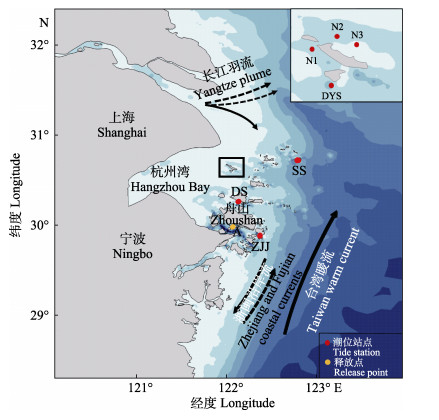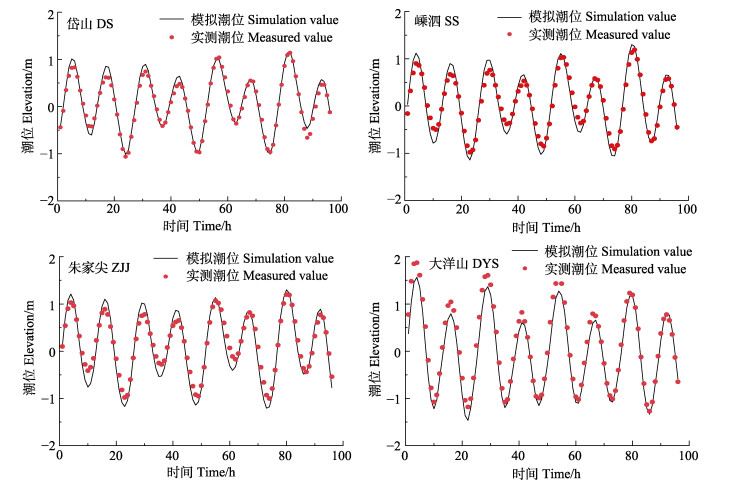2. 浙江海洋大学海洋工程装备学院 浙江 舟山 316022;
3. 自然资源部东海局舟山海洋工作站 浙江 舟山 316022
2. College of Marine Engineering Equipment, Zhejiang Ocean University, Zhoushan 316022, China;
3. Zhoushan Marine Workstation, East China Sea Bureau, Ministry of Natural Resources, Zhoushan 316022, China
当前,对微塑料污染的主要研究方法为现场取样—实验室分析—仪器鉴定—数据分析(Yin et al, 2022)。但海洋中微塑料受到海洋动力学的影响,例如潮汐、径流、风场和表面流等物理过程,分布不均匀,同时会随着时间发生变化(Sun et al, 2022)。由于现场观测的数据有限,难以得到区域内微塑料的整体丰度情况以及迁移特性。数值模拟的发展和成熟为研究海洋污染物扩散和迁移提供了一种新方法。Sun等(2022)通过SCHISM模拟东海微塑料的丰度结果与实测数据作对比,并利用模型反向粒子追踪技术,确定了中国东海微塑料的3个主要污染源。Zhang等(2020)通过ZECOM模型研究了潮汐动力在东海和邻近海域的微塑料输运中的影响。较其他模型,Mike 21适用于河流、湖泊、河口、海湾和海洋的模拟,已成功应用于研究世界各地的水动力模拟,如铁山港湾(中国)(Jiang et al, 2017)、万丹湾(印度尼西亚)(Wisha et al, 2022)和印度东南沿海(Ranjani et al, 2022)等,软件包含多种模块,能满足研究人员的不同需求。
微塑料的尺寸与水体中浮游动物等低营养级生物十分相似(仇付国等, 2022),进入水体的微塑料容易被鱼类或底栖生物吞食并聚集在肠道(Mendoza et al, 2022)和胃(Dantas et al, 2020)中,造成生物肠道损伤、进食困难及摄食行为的改变,影响生物对营养物质的吸收及自身的生长发育(Guzzetti et al, 2018; 陈胜军等, 2023),可能会降低海水养殖产量,从而影响渔业经济。此外,微塑料较大的比表面积会使其表面吸附重金属和其他污染物,当微塑料在食物链中传递时,其表面的污染物也会随之传递,最终可能富集在人身上(Tang et al, 2021),对人体造成潜在的危害。
因此,本文将采用数值模拟的方法模拟团鸡山岛发生微塑料的泄漏事件,预测微塑料的迁移及分布,并量化分析微塑料分布对水产养殖业带来的潜在影响,研究成果将加深了解微塑料对团鸡山岛潜在的生态危害,同时对舟山群岛附近海域微塑料污染治理提供理论依据。
1 材料与方法 1.1 研究区域舟山群岛位于浙江东北部,西靠杭州湾,北接长江口。舟山岛屿众多,海岸线曲折,水动力条件复杂(图 1),舟山群岛受东亚季风影响较大,冬季盛行偏北风,夏季盛行偏南风(Tseng et al, 2000)。该区域主要的来水为钱塘江的径流,舟山群岛河流会产生一定的径流,由于量较小,因此在本研究中未考虑。同时,该区域容易受到浙闽沿岸流(ZMCC)、台湾暖流(TWC)和长江羽流(CP)的影响(图 1)。浙闽沿岸流(ZMCC)冬季向南流动,夏季向北流动(Wu et al, 2018);台湾暖流(TWC)是黑潮的支流,具有高温高盐的特点,全年沿着50 m等深线附近向北流动;长江羽流(CP)是由中国最大的河流长江产生,夏季向东北方向流动,冬季沿海岸向南流动(Wu et al, 2014)。

|
图 1 研究区域主要洋流分布示意图 Fig.1 Distribution diagram of major ocean currents in the study area |
团鸡山岛位于浙江省舟山市定海区南约5.7 km的海面上,面积约为0.274 km2 (图 2),该岛原为无人岛,但在20世纪80年代成为定海和沈家门两个城区的垃圾填埋场。近年来,随着城市的不断发展和垃圾产生量的不断增加,团鸡山岛的垃圾填埋能力逐渐饱和。垃圾填埋场的环境较为复杂,具有盐度高、温度波动、pH波动、气体产生(例如CO2和CH4)、物理压力以及生物降解等恶劣条件,会使暴露在环境中的塑料废弃物破裂形成微塑料,即粒径小于5 mm的塑料颗粒(Thompson et al, 2004)。有研究表明,随着填埋年龄的增长,微塑料的动态生成呈指数型增长(Huang et al, 2022)且可能通过垃圾渗滤液而进入土壤(Alimi et al, 2018);Kazour等(2019)研究发现,沿海垃圾填埋场可能会导致微塑料进入海洋。种种证据表明垃圾填埋场是环境中微塑料的一个重要来源。相较于陆地上的垃圾填埋场,位于海岛上的垃圾填埋场泄漏的微塑料会直接进入海洋,因此,团鸡山岛垃圾填埋场是一个潜在的微塑料的污染源。团鸡山岛所在的舟山群岛,位于浙江东部,毗邻舟山渔场,同时近海水产养殖业比较发达,根据2022年舟山市统计年鉴(舟山市统计局, 2022),2021年在定海、普陀、岱山和嵊泗的海水养殖面积分别为343、1 477、586和1 520 hm2,且主要以蛏子(Sinonovacula constricta)、贻贝(Mytilius edulis)、蛤(Clam)和对虾(Penaeus chinensis)养殖为主,舟山部分水产养殖区域如图 3所示。因此,当团鸡山岛上的微塑料泄漏进入海洋后,可能会对舟山渔业造成破坏,引起严重的生态环境问题。

|
图 2 团鸡山岛卫星地图 Fig.2 Satellite map of Tuanjishan Island |

|
图 3 舟山岛近海水产养殖分布图 Fig.3 Distribution map of offshore aquaculture on Zhoushan Island |
本研究采用Mike 21 FM水动力模块结合粒子追踪模块研究舟山群岛微塑料的迁移情况。水动力模块是Mike 21 FM模型的基础模块,利用水动力模块获取了舟山群岛附近海域的流动特征,正确建立后为其他模块提供准确的水动力条件。粒子追踪模块是研究水体中物质命运的一种重要方法,该模块利用拉格朗日离散,将总物质分为带有三维坐标和质量的多个粒子,模拟微塑料粒子的迁移特性及空间分布特性。
1.2.1 模型建立和参数设置采用非结构化网格剖分研究区域,模型范围为120°E~124°E、28.5°N~33°N。模型中的水深数据来自海图,所有地形数据均采用1985国家高程基准。模型的初始网格由地表水模拟软件(SMS)生成,模型中共有62 614个节点、118 040个网格。近岸处网格分辨率为400 m,外海处网格分辨率为34 500 m,最终研究区域的网格和水深如图 4所示。

|
图 4 研究区域网格和水深图 Fig.4 Grid and water depth map of the study area |
模拟时间为2015年1月2日—2016年3月1日,模型时间步长为180 s。采用Samagorinsky亚网格尺度模型来计算水平涡粘系数,并将Samagorinsky系数取为0.28。模型中底床摩擦力用曼宁数表征,模型中取值为30~114 m1/3/s。潮汐边界条件由全球潮汐模型数据的潮汐预测提供。模型中还加入风场,数据由欧洲中期天气预报中心(ECMWF)提供。此外,长江口采用大通站的日平均流量,数据由长江水利委员会提供。钱塘江采用月平均流量,数据由浙江水文提供。
1.2.2 水动力模型验证验证资料采用2015年1月和2015年5月的水文观测数据,观测站点分布在小洋山、大洋山、岱山、嵊泗和朱家尖附近(图 1)。其中,潮位验证采用2015年1月28日—2015年1月31日岱山(DS)、嵊泗(SS)和朱家尖(ZZJ)的潮位观测数据和2015年5月10日—2015年5月13日大洋山(DYS)的潮位观测数据,潮流验证采用小洋山附近小潮、中潮和大潮时期的实测数据,取海表面的流速流向与模型模拟结果作比较。其中,小潮实测数据的时间段为2015年5月12日11:00—2015年5月13日14:00,中潮实测数据的时间段为2015年5月7日12:00—2015年5月7日15:00,大潮实测数据的时间段为2015年5月4日10:00—2015年5月5日13:00。潮位和潮流验证图分别如图 5和图 6所示。

|
图 5 2015年潮位验证 Fig.5 2015 tidal level verification |

|
图 6 小洋山N1潮位站分别在大潮、中潮和小潮期间的潮流验证图 Fig.6 Tidal flow verification diagram of N1 tide station at Xiaoyangshan during spring tide, medium tide and neap tide respectively |
为了评估模型的准确性,使用技能分数(Willmott, 1981)进行评价,其计算公式如下:
| $S=1-\frac{\sum\limits_{i=1}^N|M-D|^2}{\sum\limits_{i=1}^N(|M-\bar{D}|+|D-\bar{D}|)^2}$ | (1) |
式中,M表示模型模拟值,D表示实测值,D表示实测平均值。技能分数(S)的范围介于0~1,当S > 0.65时,模型准确性极好;当0.5 < S < 0.65时,模型准确性非常好;当0.2 < S < 0.5时,模型准确性好;当S < 0.2时,模型准确性差。
经计算,所有站点的潮位和潮流验证时S均大于0.9,表示模型准确性极好,具体数据如表 1所示。
|
|
表 1 海洋潮位和潮流验证的技能分数 Tab.1 Skill scores for marine tidal level and tidal current verification |
为了研究团鸡山岛在不同季节发生泄漏事件后微塑料的分布情况,分别在春、夏、秋、冬四个季节初期进行了微塑料粒子的连续释放实验,释放位置见图 1释放点A处。实地调查发现,河流中的微塑料主要以低密度微塑料为主,如聚乙烯、聚丙烯和人造纤维素等,密度均低于海水密度(Chen et al, 2023),因此,设置所有释放粒子为漂浮粒子。为保证所有释放的微塑料粒子均能漂浮在海面上,规定模型中微塑料粒子的沉降速度为–0.01 m/s,释放规律为在释放点0 m水深处每6 h释放1个微塑料粒子。为了解微塑料释放后的分布情况,将研究区域划分为0.01°×0.01°的网格单元,模型运行后记录每个粒子的运动轨迹及其在各个时刻的位置坐标,统计微塑料粒子在每个网格单元中出现的次数并作为模型中微塑料的相对丰度。单个区域的微塑料的分布占比计算按照微塑料粒子在单个区域网格单元中出现的次数在总区域的占比。
2 结果与讨论 2.1 微塑料的迁移特性如图 7所示,结果表明,微塑料的迁移路径主要在舟山群岛附近。春季,偏北风逐渐减弱,甚至转变为偏南风,南向流动的浙闽沿岸流(ZMCC)逐渐减弱,团鸡山岛释放的微塑料主要集中在舟山群岛附近。夏季,在南风的作用下,台湾暖流(TWC)逐渐加强,且长江羽流(CP)、浙闽沿岸流(ZMCC)均向东北流动,因此,团鸡山岛释放的微塑料开始向东北方向扩散。秋季,季风风向逐渐由偏南风变为偏北风,向北的洋流作用也开始减弱甚至转向,导致微塑料向北扩散的数量较少,主要迁移方向为沿着浙闽沿岸向南迁移。冬季,浙闽沿岸流(ZMCC)顺着海岸向南流动,长江羽流(CP)则沿着浙江沿海向西南延伸,而台湾暖流(TWC)向东北流动,且季风方向变为偏北风,此时微塑料主要沿着浙闽沿岸向南迁移。且大部分微塑料会停留在舟山岛附近海域,少部分微塑料会向东北或南部海域扩散。

|
图 7 团鸡山岛在不同季节释放的粒子的分布 Fig.7 Distribution of particles released in different seasons on Tuanjishan Island |
整体而言,不同季节释放的微塑料主要集中在122.5°E以内的近海沿岸区域沿海海域,并没有进入到东海。Cao等(2021)研究发现,该研究区域内存在2个锋面,一个是杭州湾的锋面,呈现从钱塘江河口向东北延伸的模式;另一个是与海岸线平行的离岸较远的大陆架锋面,且在秋季和冬季,这2个锋面的活动非常强烈。锋面可以阻止物质的横向运输(Castelao et al, 2014),因此,团鸡山产生的微塑料将主要集中在近海海域,并不会进入东海。
2.2 微塑料的季节性分布规律分析微塑料的分布情况,可以看到大量的微塑料聚集在深水航道中,通过计算,春季、夏季、秋季和冬季深水航道中的微塑料占比分别为38%、36%、44%和42%。Wang等(2020)的实地调查发现,在整个杭州湾中,宁波港和航行区附近微塑料的丰度最高。此外,Wang等(2021)研究发现,在舟山岛与宁波之间航道的水体中容易聚集常见的有机污染物邻苯二甲酸酯,因此,深水航道是污染物易聚集的区域。此外,在舟山岛北部也形成一个微塑料的聚集区域,经计算,春季、夏季、秋季和冬季聚集在舟山岛北部的微塑料分别占比9%、10%、8%和6%。舟山海域潮汐具有不对称性,具体表现为涨潮占优(张雨豪等, 2020),且涨潮方向为自东南向西北(熊伟等, 2011),在涨潮的作用下,团鸡山岛释放的微塑料粒子将会向西北方向迁移,部分微塑料进入到舟山岛的西北部,随水流进入舟山岛的北部海域,甚至部分会进入到岱山岛的北部,形成微塑料的热点区域。
团鸡山岛释放微塑料后,会有部分微塑料进入到象山湾,象山湾是一个狭长而半封闭的海湾,潮汐特点为半日潮,水的停留时间长,由于地理和水文特征,海湾与外海交换水的能力较差,从而会将微塑料保留在海湾中(Li et al, 2017)。此外,全年波浪作用较弱,海湾内的水循环主要由潮汐驱动,这可能导致海湾中微塑料的大量积累。经计算,在冬季大概有2%的微塑料会聚集在此,Chen等(2018)研究表明,海湾内海水和沉积物的平均微塑料丰度为(8.90±4.70)个/m3和(174±215)个/kg。
团鸡山岛发生微塑料泄漏后,在海洋动力环境下发生迁移,入海的微塑料除大量聚集在深水航道附近、舟山岛北部海域外,还会聚集在各养殖区域。经过计算,进入到各海水网箱养殖点的占比如表 2所示。积聚在这些区域的微塑料可能会对近海水产养殖业有较大的影响,特别对团鸡山西北方向2个养殖区域。
|
|
表 2 微塑料迁移至各养殖区所占比例 Tab.2 Proportion of microplastics migrating to each culture area |
因此,由团鸡山岛释放的微塑料更倾向于在航道区聚集,此外,还在舟山岛北部近海海域形成微塑料热点区域。综上所述,由团鸡山岛释放的微塑料主要有2个去向,一是宁波与舟山岛之间的深水航道,春季、夏季、秋季和冬季微塑料在此聚集的数量分别为38%、36%、44%和42%;二是舟山岛北部近海海域,春季、夏季、秋季和冬季聚集的微塑料分别占比9%、10%、8%和6%。因此,若发生相关泄漏事件时,可以重点关注深水航道和舟山岛北部近海海域这2个区域。
2.3 微塑料释放后的影响综上所述,微塑料迁移至养殖区所占比例较高的主要是7#(2.80%)、9#(3.85%)、13#(10.11%)和14#(10.11%),团鸡山岛微塑料泄漏可能会对近海水产养殖业生产和经济造成不利影响。Devriese等(2015)研究了北海南部和海峡地区浅水栖息地的褐虾(Metapenaeus dobsoni)中微塑料的含量后发现,63%的受试虾体内存在大小在200~1 000 µm之间的塑料纤维。Zhang等(2021)在调查了中国胶州湾蛤蜊(Concha mactrae veneriformis)和牡蛎(Ostrea gigas thunberg)中微塑料的污染情况后发现,胶州湾贝类中的微塑料污染处于中等水平,所有贝类中摄入的微塑料的平均丰度为1.21个/g,其中,蛤蜊为1.51个/g,牡蛎为0.920个/g。这些研究表明,大量海洋水生生物已经受到微塑料的污染,尤其是海洋中的养殖业。此外,象山港已被广泛用于海水养殖,包括养殖螃蟹(Brachyura)的圈地养殖、养殖牡蛎和海藻(Sargassum)的筏式养殖、养殖鱼类的网箱养殖和养殖蛤蜊的滩涂养殖,且有研究证明,这些海水养殖生物已受到微塑料的污染(Chen et al, 2018; 梁帅等, 2021; 郑旭颖等, 2023)。
团鸡山岛释放的微塑料在冬季大概有2%的微塑料会迁移至象山湾,会对湾内的野生生物及近海海水养殖生物产生较大的影响。滕佳(2021)研究表明,摄入微塑料的牡蛎的摄食率和呼吸率下降,并诱导了氧化应激。此外,PE和PET微塑料都抑制了牡蛎的脂质代谢,同时,还观察到牡蛎出现消化管坏死、组织间质减少等组织病理学损伤以及改变牡蛎的脂质和葡萄糖代谢过程等毒性效应(滕佳, 2021)。此外,微塑料不仅会进入水生生物体内,还会对海洋食物链产生影响,威胁整个海洋生态系统的稳定性(Tang et al, 2021)。
3 结论团鸡山岛作为舟山的主要垃圾岛,具有一定的环境风险,本研究关注从团鸡山可能泄露的微塑料污染,基于Mike建立了微塑料的迁移模型,分析了微塑料的迁移和分布特性。由于受到海洋锋面的影响,微塑料主要分布在舟山群岛的近海海域,因受到沿海环流的季节性变化的影响,部分微塑料会进入到象山港以南以及嵊泗岛。在深水航道及舟山岛北部近海海域,形成2个微塑料热点区域,若团鸡山岛微塑料发生泄露可以重点关注这2个区域,这为微塑料泄露的预防和治理提供了数据支撑。
团鸡山岛泄露的微塑料主要分布在舟山岛近海海域,因此,对舟山渔场的影响较小,但对近海水产养殖业有较大影响。进入象山港的微塑料难以再次迁移出湾内,可能会对象山港内野生生物和养殖业产生不利影响。微塑料不仅会进入水生生物体内,还会对海洋食物链产生影响,威胁整个海洋生态系统的稳定性。
但目前的模型忽略了微塑料的吸附、生物污染和沉降等过程,随着微塑料在海洋中停留时间的延长,其物理和化学性质也会发生改变。因此,今后的研究应充分考虑微塑料在海洋中经历的所有过程,才能更全面地评估沿海地区微塑料的迁移情况。
ALIMI O S, FARNER BUDARZ J, HERNANDEZ L M, et al. Microplastics and nanoplastics in aquatic environments: Aggregation, deposition, and enhanced contaminant transport. Environmental Science and Technology, 2018, 52(4): 1704-1724 DOI:10.1021/acs.est.7b05559 |
CAO L, TANG R, HUANG W, et al. Seasonal variability and dynamics of coastal sea surface temperature fronts in the East China Sea. Ocean Dynamics, 2021, 71: 237-249 DOI:10.1007/s10236-020-01427-8 |
CASTELAO R M, WANG Y. Wind-driven variability in sea surface temperature front distribution in the California current system. Journal of Geophysical Research: Oceans, 2014, 119(3): 1861-1875 DOI:10.1002/2013JC009531 |
CHEN M, JIN M, TAO P, et al. Assessment of microplastics derived from mariculture in Xiangshan Bay, China. Environmental Pollution, 2018, 242: 1146-1156 DOI:10.1016/j.envpol.2018.07.133 |
CHEN S J, GAO F F, WANG D, et al. Research progress on the source and generation mechanism of amino urea in crustacean aquatic products. Fisheries Science Progress, 2023, 44(4): 244-253 [陈胜军, 高芳芳, 王迪, 等. 甲壳类水产品中氨基脲的来源及生成机理研究进展. 渔业科学进展, 2023, 44(4): 244-253] |
CHEN W, CAO L, JIN Z, et al. Characteristics and patterns of microplastic distribution in Zhoushan. In: ZHANG J, RUAN R, BASHIR M J K. (eds) Environmental Pollution Governance and Ecological Remediation Technology. ICEPG 2022. Environmental Science and Engineering, Springer, Cham, 2023
|
DANTAS N C F M, DUARTE O S, FERREIRA W C, et al. Plastic intake does not depend on fish eating habits: Identification of microplastics in the stomach contents of fish on an urban beach in Brazil. Marine Pollution Bulletin, 2020, 153: 110959 DOI:10.1016/j.marpolbul.2020.110959 |
DEVRIESE L I, VAN DER MEULEN M D, MAES T, et al. Microplastic contamination in brown shrimp (Crangon crangon, Linnaeus 1758) from coastal waters of the Southern North Sea and Channel area. Marine Pollution Bulletin, 2015, 98(1/2): 179-187 |
GUZZETTI E, SUREDA A, TEJADA S, et al. Microplastic in marine organism: Environmental and toxicological effects. Environmental Toxicology and Pharmacology, 2018, 64: 164-171 DOI:10.1016/j.etap.2018.10.009 |
HUANG Q, CHENG Z, YANG C, et al. Booming microplastics generation in landfill: An exponential evolution process under temporal pattern. Water Research, 2022, 223: 119035 DOI:10.1016/j.watres.2022.119035 |
JIANG C, LIU Y, LONG Y, et al. Estimation of residence time and transport trajectory in Tieshangang Bay, China. Water, 2017, 9(5): 321 DOI:10.3390/w9050321 |
KAZOUR M, JEMAA S, ISSA C, et al. Microplastics pollution along the Lebanese coast (Eastern Mediterranean Basin): Occurrence in surface water, sediments and biota samples. Science of the Total Environment, 2019, 696: 133933 DOI:10.1016/j.scitotenv.2019.133933 |
LI L, GUAN W, HE Z, et al. Responses of water environment to tidal flat reduction in Xiangshan Bay: Part Ⅱ locally re-suspended sediment dynamics. Estuarine, Coastal and Shelf Science, 2017, 198(5): 114-127 |
LIANG S, HAN B, NIU Z P, et al. Sources, migration pathways and ecotoxicological effects of microplastics in freshwater. Environmental Engineering, 2021, 39(12): 1–9, 70 [梁帅, 韩冰, 牛泽普, 等. 淡水中微塑料的来源、迁移途径及生态毒理效应综述. 环境工程, 2021, 39(12): 1–9, 70] |
MENDOZA S M, FERNANDEZ V H, BARRIOS M, et al. Microplastics in gut content of juveniles of the patagonic silverside fish Odontesthes sp. Marine Pollution Bulletin, 2022, 182: 113876 DOI:10.1016/j.marpolbul.2022.113876 |
QIU F G, TONG S Y, WANG X Q. Research progress of microplastics occurrence and ecological hazards in water environment. Environmental Engineering, 2022, 40(3): 221-228 [仇付国, 童诗雨, 王肖倩. 水环境中微塑料赋存现状及生态危害研究进展. 环境工程, 2022, 40(3): 221-228] |
RANJANI M, VEERASINGAM S, VENKATACHALAPATHY R, et al. Seasonal variation, polymer hazard risk and controlling factors of microplastics in beach sediments along the southeast coast of India. Environmental Pollution, 2022, 305: 119315 DOI:10.1016/j.envpol.2022.119315 |
SUN Y, CAO L, WANG Y, et al. Sources and distribution of microplastics in the East China Sea under a three-dimensional numerical modelling. Environmental Pollution, 2022, 311: 119910 DOI:10.1016/j.envpol.2022.119910 |
TANG Y, LIU Y, CHEN Y, et al. A review: Research progress on microplastic pollutants in aquatic environments. Science of the Total Environment, 2021, 766: 142572 DOI:10.1016/j.scitotenv.2020.142572 |
TENG J. Study on the pollution characteristics of microplastics in Laizhou Bay and their ecotoxicity effects on typical bivalves. Doctoral Dissertation of University of Chinese Academy of Sciences (Yantai Institute of Coastal Zone, Chinese Academy of Sciences), 2021 [滕佳. 莱州湾微塑料污染特征及其对典型双壳贝类生态毒性效应研究. 中国科学院大学(中国科学院烟台海岸带研究所)博士研究生学位论文, 2021]
|
THOMPSON R C, OLSEN Y, MITCHELL R P, et al. Lost at sea: Where is all the plastic?. Science, 2004, 304(5672): 838-838 DOI:10.1126/science.1094559 |
TSENG C, LIN C, CHEN S, et al. Temporal and spatial variations of sea surface temperature in the East China Sea. Continental Shelf Research, 2000, 20(4/5): 373-387 |
WANG L Y, GU Y Y, ZHANG Z M, et al. Contaminant occurrence, mobility and ecological risk assessment of phthalate esters in the sediment-water system of the Hangzhou Bay. Science of the Total Environment, 2021, 770: 144705 DOI:10.1016/j.scitotenv.2020.144705 |
WANG T, HU M, SONG L, et al. Coastal zone use influences the spatial distribution of microplastics in Hangzhou Bay, China. Environmental Pollution, 2020, 266: 115137 DOI:10.1016/j.envpol.2020.115137 |
WILLMOTT C J. On the validation of models. Physical Geography, 1981, 2(2): 184-194 DOI:10.1080/02723646.1981.10642213 |
WISHA U J, GEMILANG W A, WIJAYA Y J, et al. Model-based estimation of plastic debris accumulation in Banten Bay, Indonesia, using particle tracking-Flow model hydrodynamics approach. Ocean and Coastal Management, 2022, 217: 106009 DOI:10.1016/j.ocecoaman.2021.106009 |
WU H, SHEN J, ZHU J, et al. Characteristics of the Changjiang plume and its extension along the Jiangsu coast. Continental Shelf Research, 2014, 76: 108-123 DOI:10.1016/j.csr.2014.01.007 |
WU T, WU H. Tidal mixing sustains a bottom-trapped river plume and buoyant coastal current on an energetic continental shelf. Journal of Geophysical Research: Oceans, 2018, 123(11): 8026-8051 DOI:10.1029/2018JC014105 |
XIONG W, LIU B J, SUN Z C, et al. Three-dimensional tidal current numerical simulation near Zhoushan, Ningbo. Journal of Hydroport, 2011, 32(6): 399-407 [熊伟, 刘必劲, 孙昭晨, 等. 宁波舟山近海三维潮汐潮流数值模拟. 水道港口, 2011, 32(6): 399-407 DOI:10.3969/j.issn.1005-8443.2011.06.003] |
YIN M, CAO H, ZHAO W, et al. Tide-driven microplastics transport in an elongated semi-closed bay: A case study in Xiangshan Bay, China. Science of the Total Environment, 2022, 846: 157374 DOI:10.1016/j.scitotenv.2022.157374 |
ZHANG K, LIANG J, LIU T, et al. Abundance and characteristics of microplastics in shellfish from Jiaozhou Bay, China. Journal of Oceanology and Limnology, 2022, 40(1): 163-172 |
ZHANG Y H, WU X T, TONG C F, et al. Discussion on deformation and asymmetry of tidal wave propagation in Zhoushan Islands. Hydroport, 2020, 41(1): 9-15 [张雨豪, 吴心彤, 童朝锋, 等. 舟山群岛海域潮波传播变形和不对称性探讨. 水道港口, 2020, 41(1): 9-15] |
ZHANG Z, WU H, PENG G, et al. Coastal ocean dynamics reduce the export of microplastics to the open ocean. Science of the Total Environment, 2020, 713: 136634 |
ZHENG X Y, LI Z X, SUN X J, et al. Monitoring and risk assessment of diarrheal and paralytic shellfish toxins in Tangshan shellfish aquaculture area of Bohai Sea. Progress in Fishery Sciences, 2023, 44(5): 231-241 [郑旭颖, 李兆新, 孙晓杰, 等. 渤海海域唐山贝类养殖区腹泻性和麻痹性贝类毒素的监测与风险评估. 渔业科学进展, 2023, 44(5): 231-241] |
Zhoushan City Bureau of Statistics. Statistical yearbook. 2022 http://zstj.zhoushan.gov.cn/col/col1229705814/index.html [舟山市统计局. 统计年鉴. 2022 http://zstj.zhoushan.gov.cn/col/col1229705814/index.html]
|



